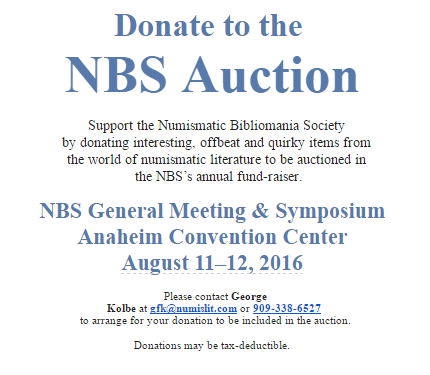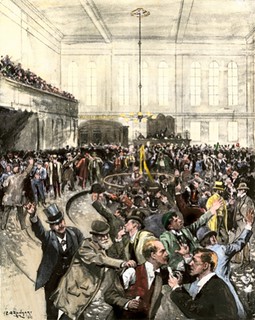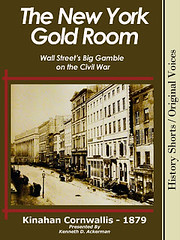
PREV ARTICLE
NEXT ARTICLE
FULL ISSUE
PREV FULL ISSUE
THE NEW YORK GOLD ROOMDavid Sundman writes: E-Sylum readers may find this short article on the Gold Room in New York during the U.S. Civil War of interest. The account is from the Treasury Historical Association’s June newsletter. Regulating Wall Street During the Civil War
Very rapidly, financial elites found themselves entangled in this new world of "greenbacks." Federal monetary policy and progress on the battlefield began to exercise greater control over the course of business in the North. Financiers in New York City eventually stumbled upon a way to leverage this new state of affairs with the creation of a thriving trade in futures contracts for gold. The most important of these markets was the New York “Gold Room.” In the Gold Room, Bulls could buy gold for greenbacks, often trying to capitalize on recent Union defeats on the battlefield. Gold Room trades quickly highlighted the precarious hold of the government over the economy of the North, as the quote on the price of gold in greenback dollars became the prime financial indicator of the Union's economic health affecting prices and the ability of the government to finance the war. Over the course of the war, government leaders would find themselves incapable of controlling or understanding this market that they helped create, while financial leaders would discover that this new central power in the market was equally uncontrollable. In the summer of 1864, Congress attempted something new in American history: they banned all future contracts for gold. The Gold Room promptly closed its doors. Yet, without a real power to enforce the law, traders merely carried on the trade in secret and pushed the price of gold to an all-new high. Shocked by their failure, Congress repealed the law less than a month later. Until the resumption of specie payment in 1879, the only reliable means for federal leaders to regulate the price of gold and greenbacks was to sell the Treasury’s gold reserves on the open market. Rather than a curiosity of the Civil War Era, the issue of the Gold Room stands as an early chapter in the story of the relationship between the federal government and Wall Street that would develop in fits and starts over the next 150 years. For more information on the Treasury Historical Association, see:
Thanks. Looking online for more information I discovered this book on the history of the New York Gold Room. Here's an excerpt from
the publisher's blog, which was the source of the picture I added above (the Treasury Historical Association was unillustrated).
-Editor
A British-born writer named Kinahan Cornwallis (1839-1917) witnessed this event while working in New York City as a reporter for the New York Herald. We at Viral History Press LLC are proud now to bring you Kinahan's account, first published in pamphlet form by A.S. Barnes & Company in 1879... To read the complete article, see:

Wayne Homren, Editor The Numismatic Bibliomania Society is a non-profit organization promoting numismatic literature. See our web site at coinbooks.org. To submit items for publication in The E-Sylum, write to the Editor at this address: whomren@gmail.com To subscribe go to: https://my.binhost.com/lists/listinfo/esylum All Rights Reserved. NBS Home Page Contact the NBS webmaster 
|

